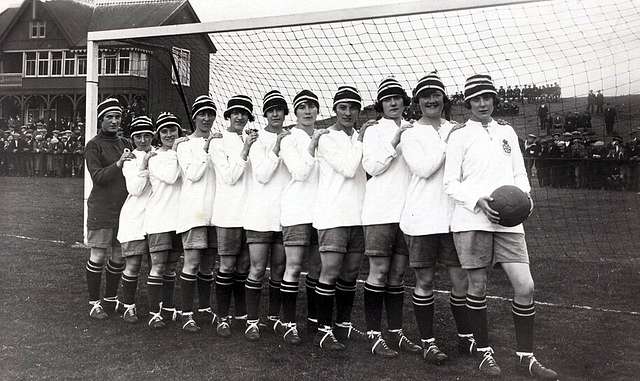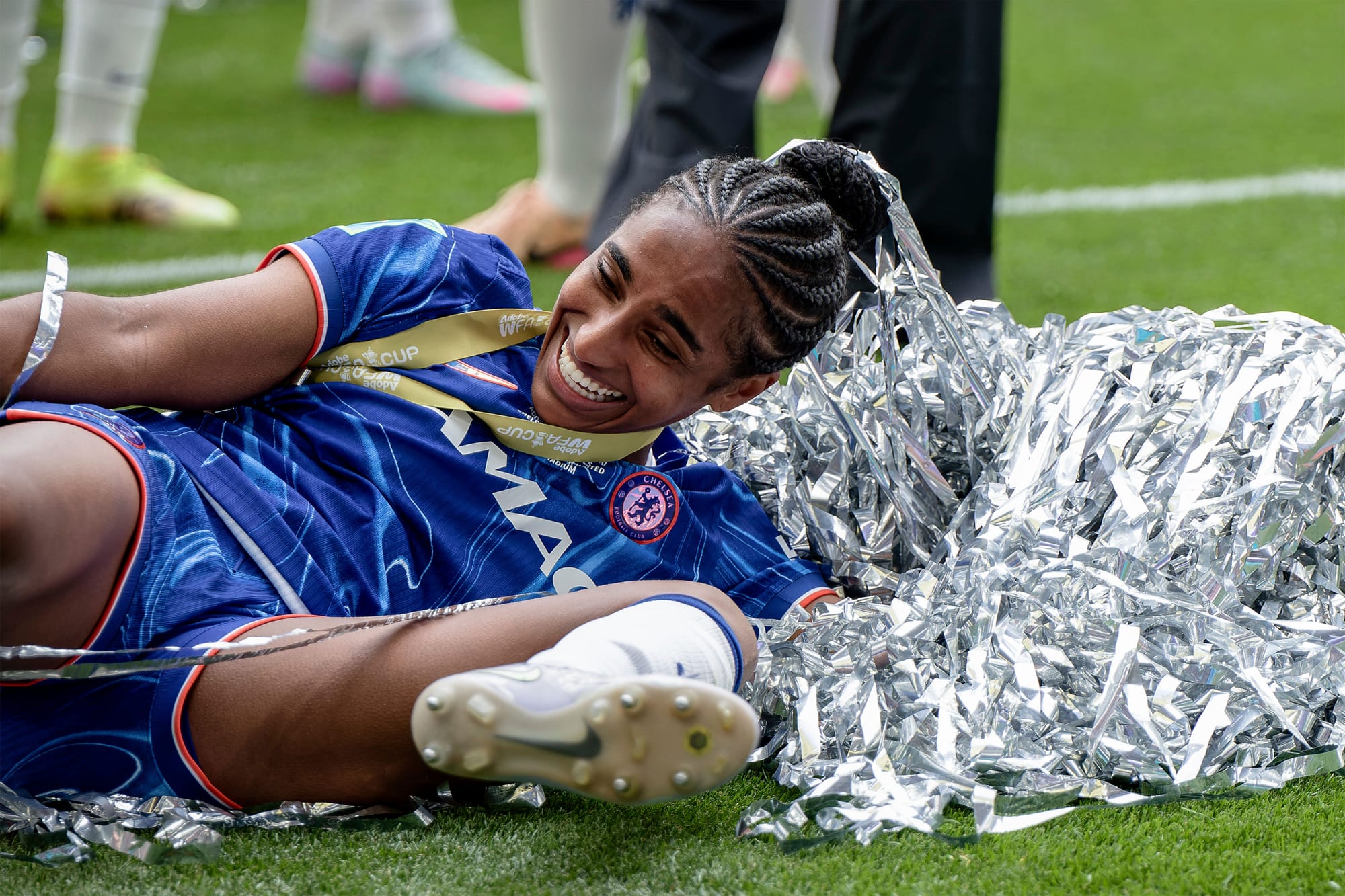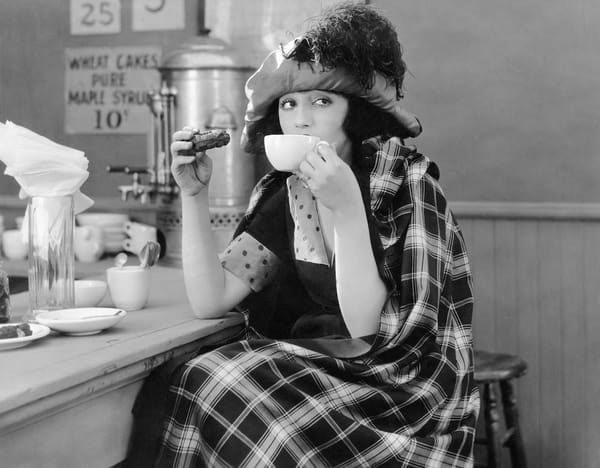When Soccer Wasn’t Such a Guy Thing
Women’s soccer in the U.K. goes way back in history. But at one point it was banned. By the time the ban was lifted, the damage had been done.

It’s 7:50 on a Sunday morning and my husband and I are loading our two small daughters and a vast bag of snacks onto a creaky double-decker bus.
We’re headed to—of all places—Wembley Stadium, the vast 90,000-seat arena that has served as a stage for the likes of Madonna, Beyoncé, Taylor Swift and Adele; as well as the backdrop for the F.A. Cup finals (including the recent 2025 final between Crystal Palace and Manchester City), the Rugby Champions Cup Finals and it has played host to various NFL teams since 2007, including the Jacksonville Jaguars and the New York Giants. So, you know, no big deal.
The latest on this long list of celebrities and celebrity teams is my very own hyper-local football team, Whitstable Town.
Before I go on, let me be clear about a few things: Whitstable, where I live, is a seaside town best known for its oysters. It’s 50 miles south-east of London and its biggest claim to fame is its (brief) appearance in the risqué, early noughties television show, “Tipping the Velvet.” It is not, in other words, one of England’s great soccer towns.
But it just so happens that our local football team, Whitstable Town, has performed well this season, well enough indeed that they qualified for the final; a match that will be played at Wembley. And fully one-third of Whitstable (population: 32,000) is going to watch.
An Ocean of Men
By the time our bus from Whitstable arrives at Wembley’s parking garage, the kids have worked themselves into a frenzy. As we disembark, my 2-year-old keeps locking eyes with random strangers and chanting “WEM-BER-MEEEE.” In keeping with British soccer tradition, we (mum and dad) buy, and then sink, two pints of lager in quick succession. The kids eat chips. Then we head inside.
To say that Wembley Stadium is male-coded on a day like this, is like pointing out that the sky is blue or that Donald Trump’s policies are not particularly inclusive: It’s so obvious as to almost not be worth stating.
Where we are sitting, we are surrounded by men. In front of us, a row of men in their late forties; to the left of us, a throng of teenage boys. To join in with chants (“Sea! Side! Sea siders!”), my daughters deepen their squeaky little-girl voices as much as they can, because British soccer chants must always be performed in a deep, masculine, baritone.
Although British soccer is known for its hooliganism, today a more cheerful sort of masculinity is on display. It’s men in their happy place. When they’re not gleefully hurling insults at the referee, the men in front of us make a fuss of my 2-year-old. They are, after all, parents themselves.
But sitting here, surrounded by these cheerful men, I am reminded of the fact that soccer was not ever thus. British soccer has not always been a men-focused sport.
A Sport for Women
In this very stadium in 2022, England’s women’s soccer team, the Lionesses, won the Euros— Europe’s biggest tournament—against Germany. To many people’s surprise, the match drew a crowd of more than 87,000 people, a record attendance for any UEFA (that’s the Union of European Football Associations, Europe’s governing body of national governing bodies of soccer) tournament.
For the Lionesses, the win was significant. But it was hardly a first, and that’s because women have been playing football for years.
Historically, soccer has long been popular with women: In a 1580 poem (yes, 1580, Shakespeare’s time), Sir Philip Sidney describes a mother who,
“with skirts tuckt very hy, with girles at football playes.”
The earliest recorded women’s match was in 1881 at Edinburgh’s Easter Road, when Scotland played England and won (though many of the details of the match are fuzzy).
But women’s soccer really took off during the First World War, when workers at various British munitions factories formed their own league, with 30 teams and a prize—the Munitionettes Cup.

The games attracted massive crowds. On Boxing Day in 1920, a crowd of 53,000 showed up to watch Dick, Kerr Ladies F.C. beat St. Helens Ladies 4-0 at Goodison Park; a further 10,000 people were turned away. It was an attendance record that wouldn’t be surpassed for another 92 years, according to the football writer Suzanne Wrack in her book “A Woman’s Game.” (At the London 2012 Olympics, it was finally topped when 70,584 people watched Team GB beat Brazil at—you guessed it—Wembley.)
The 1920 Boxing Day game raised £3,000 (about £140,000 in today’s money, or $188,000) for unemployed and disabled ex-servicemen, “an easy record for a charity match in England,” wrote the Lancashire Evening Post.
But the match’s success would prove to be the game’s downfall. “The money raised… focused the minds of those watching…women’s teams with mistrust and trepidation,” writes Wrack. “The huge sums of money being raised were outside [the F.A.’s] jurisdiction and control. Worse still, that money was no longer being raised to support the war wounded but was being channeled into political and working-class causes—causes antithetical to the establishment.”
So, a year after that Boxing Day game, the F.A. voted to ban women’s soccer from affiliated soccer grounds. “Complaints have been made as to football being played by women,” wrote the organization’s ruling council. It went on: “The Council feel impelled to express their strong opinion that the game of football is quite unsuitable for females and ought not to be encouraged.”
It took 51 years for that ban to be lifted, but by the time it was, the damage had been done.
It took 51 years for that ban to be lifted, but by the time it was—in 1971 after increasing pressure from women players—the damage had been done. Being forced to play in smaller, non F.A.-affiliated stadiums meant crowds had not been able to attend the women’s games that did take place. In the U.K., soccer was, for all intents and purposes, regarded as a man’s game.

It wasn’t until 2018 that a fully professional women’s league was established and, although the pay gap between the women’s and men’s games is beginning to close, we’re still a very long way off parity. In March the American player Naomi Girma became the first player in women’s soccer to command a transfer fee of over €1 million ($1.1 million) when she moved from the San Diego Wave to Chelsea. By contrast, the men’s record was set in 2017, when Paris Saint-Germain bought Neymar (he’s a one-name kind of guy, like Jesus or Prince) from Barcelona for… €222 million.
Likewise, the highest-paid female soccer player, Barcelona's Aitana Bonmati, reportedly earns about €1 million a year, while the highest-paid male player, Cristiano Ronaldo, is expected to earn $220 million (about €196m) on the field this season.
The average salary of a player in the Women’s Super League is about 100 times less than her male counterparts. The one consolation is that, since 2020, English women and men who are playing for their country have both been paid the same fee for appearing at a match: £2,000. Which is usually donated to charity.
‘I Like Football!’
Back at Wembley, our match gets off to a miserable start as Whitstable’s opponents, A.F.C. Whyteleafe , score in the 18th minute of the game. The crowd visibly droops, but half an hour in, our hopes are raised again as Whitstable equalizes. Then, nothing. The kids ask for our phones; the men in front of us are hauled out for sneaking in beer. My phone buzzes. “Has anyone at Wembley got a children’s painkiller?” asks a member of my moms group text, whose daughter has developed a fever.
It’s not until deep into extra time that Whitstable secures a victory. “I like football!” yells my 5-year-old, who is perched on her dad’s shoulders.“WEM-BER-MEEEE!” shouts my other daughter.
On the way home, I think again about that Boxing Day game, and wonder what became of the stadium in which it was played. It turns out Goodison Park, in Liverpool, was the “first major football stadium built in England,” according to Everton, the football club for which it was built. But Everton needed a modern home befitting its Premier League status—so this month it bid farewell to the stadium it has called home since 1982, and moved two miles away to the newly-built Dickinson Hill stadium.
Meanwhile, Goodison Park, a piece of English soccer history, was earmarked for demolition—until this month when Everton’s new American owners had a change of heart, and unveiled new plans to turn it into the home for Everton Women.
In the press release announcing the decision, the chair of the team’s fan advisory board, Dave Kelly, mentioned the stadium’s illustrious role in soccer history, as “a glorious home for the men’s team since 1892.” No mention was made of the illustrious women’s Boxing Day game in 1920 which drew fans in the tens of thousands.
I guess you really do win some and you lose some.











